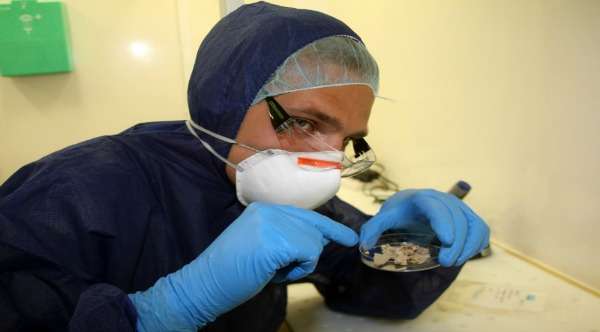Curtin PhD student Frederik Seersholm studies a bone sample at the university's Trace and Environmental DNA (TrEnD) laboratory. Credit. Rueben Hale
A DNA metabarcoding approach to study bone fragments could reveal what Western Australia's early aboriginal people ate for dinner.
Curtin PhD student Frederik Seersholm is planning to use a revolutionary approach called "Bulk Bone Metabarcoding" to analyse the eating habits of aboriginal people first arriving in Western Australia from East Asia and Africa around 50,000 years ago.
Mr Seersholm, who moved to Western Australia to study at Curtin this year, was part of a project run by the Natural History Museum of Denmark, where he and a team of researchers' developed a method of rapidly analysing DNA found in soil and pinpointing the exact genetics of a diverse range of animals to reconstruct and analyse the biodiversity in prehistoric times.
In a paper recently published in Nature Communications, the Danish team extracted DNA from kitchen middens up to 4,500 years old to reveal that bowhead whale and other large mammals including walrus, caribou and narwhal made up a bigger part of the diet of the ancient Greenlanders than previously thought.
Mr Seersholm says that using a similar technique, he would aim to analyse bones of ancient animals to find out what aboriginal people arriving from Africa and East Asia were eating in the Kimberly, Pilbara and South West parts of Western Australia when they first settled the lands.
"We are collaborating with the Western Australian Museum to obtain samples from any ongoing investigations in these areas," Mr Seersholm says.
"The technique we are going to use in Western Australia is slightly different to the one that we used on the Greenland paper because it will study a collection of bones instead of the sediment."
Mr Seersholm says he will have to refine the technique to adapt it to Western Australia's warmer climate.
"Usually only one bone is analysed at a time, but we are going to grind the bones and mix them together to make a fine bone powder and then we will genetically analyse the powder in one go," Mr Seersholm says.
"By mixing the bones we are reaching for the DNA that we want to look at, and we can add more information because small fragments of bones are normally difficult to identify, so traditional methods would quite commonly miss small animals species," he says.
More information: Frederik Valeur Seersholm et al. DNA evidence of bowhead whale exploitation by Greenlandic Paleo-Inuit 4,000 years ago, Nature Communications (2016). DOI: 10.1038/ncomms13389
Journal information: Nature Communications
Provided by Science Network WA
This article first appeared on ScienceNetwork Western Australia a science news website based at Scitech.





















